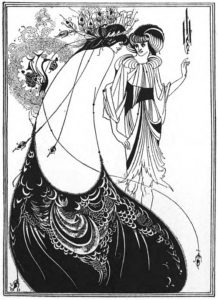
How we appear to others depends upon many cultural, political, economic, and physiological factors. Here, we will focus on the cultivated performance of identity, emotion, and the inner spirit. We will move from the history of clothes and cosmetics to the study of dance and theater, all the while investigating the ways in which humans struggle with the notion of expressing their authentic self to others.
- Denis Diderot, from “Regrets for my Old Dressing Gown” (1769)
- William Blake, “The Tyger” (1794)
- Percy Bysshe Shelley, “Sonnet: Lift Not the Painted Veil” (1824)
- Thomas Carlyle, from Sartor Resartus (1831)
- Henry Morley, from “A House Full of Horrors” (1852)
- Charles Baudelaire, “Gamblers” from Les Fleurs du Mal (1857)
- Robert Louis Stevenson, The Strange Case of Dr. Jekyll and Mr. Hyde (1886)
- Thornstein Veblen, from The Theory of the Leisure Class (1899)
- Arthur Symons, “Elenora Duse” (1900), “Rodin” (1902), and “Esther Kahn” (1905)
- Isadora Duncan, from My Life (1927)
- John Dos Passos, “Art and Isadora” from The Big Money (1933)
Experiment: Biography of a Virtual Classmate
Length: 250 words, plus 3 links
Points: 50
One of the modern ways we negotiate various representations of our identities is through social media or in other digital environments. Partner up with a classmate (who you first met in this class), and compose a brief biography of their virtual identity. Include 3 digital artifacts linked to your classmate that you used to compose your biography. (250 words)
Project: Performing Identity (100 points)
Length: 1000 words (total) + creative artifact
Points: 100
How we appear to others depends upon many cultural, political, economic, and physiological factors. Here, we will focus on the cultivated performance of identity, emotion, and the inner spirit, investigating the ways in which humans struggle with the notion of expressing their authentic self to others.
The project consists of two parts: a creative assignment and a critical essay.
| Creative | Develop a short creative piece: a poem, vignette, character study, self-portrait, monologue, choreography, or something similar. The goal of the creative piece is to explore and unleash a creative expression of our inner/outer lives. Use the texts we have explored during this module for inspiration. | 25 points |
| The creative piece should include an artist’s statement (250 words) that contextualizes the goals of the artwork—this statement is particularly important in terms of making concrete and visible what you are striving to achieve in what will inevitably be a rough and experimental artistic creation. | 25 points |
| Critical | Place your artistic creation in conversation with the texts and issues we explored in this unit. Create a thesis statement that identifies your own relationship to the questions we have explored in terms of the complexity of our inner lives, the complicated search for authenticity, and the outward performance of our identities. | 25 points |
| In order to fully engage with this historical material, you will need to include a minimum of 3 texts from the syllabus in your essay and meet a page limit of 3 pages double-spaced (or 750 words) | 25 points |
